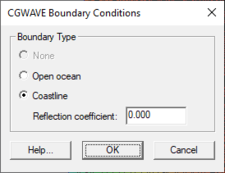SMS:CGWAVE Boundary Conditions Dialog: Difference between revisions
From XMS Wiki
Jump to navigationJump to search
No edit summary |
|||
| (7 intermediate revisions by the same user not shown) | |||
| Line 1: | Line 1: | ||
[[Image:CGWAVE BC. | [[Image:CGWAVE BC.png|thumb|225 px|''CGWAVE Boundary Condition'' dialog]] | ||
In the [[SMS:CGWAVE|CGWAVE]] model, a wave direction, amplitude and frequency must be specified at open boundaries and reflection coefficients are defined for all closed boundaries. In addition to these exterior boundaries, the model also includes the capability to simulate interior islands, and floating barriers. | In the [[SMS:CGWAVE|CGWAVE]] model, a wave direction, amplitude and frequency must be specified at open boundaries and reflection coefficients are defined for all closed boundaries. In addition to these exterior boundaries, the model also includes the capability to simulate interior islands, and floating barriers. | ||
== Assign Boundary Condition == | == Assign Boundary Condition == | ||
The ''[[SMS:CGWAVE|CGWAVE]] Boundary Conditions'' dialog is used to assign boundary conditions to individual nodestrings. This dialog is invoked with the '''Assign BC''' command in the [[SMS:CGWAVE Graphical Interface#CGWAVE Menu|''CGWAVE'' menu]]. Before assigning boundary conditions to nodestrings, at least one nodestring must be selected using the | The ''[[SMS:CGWAVE|CGWAVE]] Boundary Conditions'' dialog is used to assign boundary conditions to individual nodestrings. This dialog is invoked with the '''Assign BC''' command in the [[SMS:CGWAVE Graphical Interface#CGWAVE Menu|''CGWAVE'' menu]]. Before assigning boundary conditions to nodestrings, at least one nodestring must be selected using the [[SMS:2D Mesh Module Tools|'''Select Nodestring''']] [[File:SMS Select Nodestring Tool.svg|16 px]] tool. To assign boundary conditions to the selected nodestring(s), select one of the boundary condition options. | ||
=== Boundary Types === | === Boundary Types === | ||
| Line 9: | Line 9: | ||
* '''Open Ocean''' – Delineate the region where waves will enter the domain. The attributes of the waves that enter the domain are defined as incident wave characteristics in the [[SMS:CGWAVE Model Control|''CGWAVE Model Control'' dialog]]. These values are propagated from an offshore location to the open ocean boundaries. | * '''Open Ocean''' – Delineate the region where waves will enter the domain. The attributes of the waves that enter the domain are defined as incident wave characteristics in the [[SMS:CGWAVE Model Control|''CGWAVE Model Control'' dialog]]. These values are propagated from an offshore location to the open ocean boundaries. | ||
* '''Coastline''' – Represent a region where the wave is obstructed. At these locations, the Reflection coefficient should be set. The coastline reflection term defines to what degree a section of coastline reflects incoming waves. Legal values vary from 0.0 for a gradual sandy incline to 1.0 for solid vertical rock wall. This boundary condition may be assigned to either exterior regions of the domain, or interior holes which represent islands. | * '''Coastline''' – Represent a region where the wave is obstructed. At these locations, the Reflection coefficient should be set. The coastline reflection term defines to what degree a section of coastline reflects incoming waves. Legal values vary from 0.0 for a gradual sandy incline to 1.0 for solid vertical rock wall. This boundary condition may be assigned to either exterior regions of the domain, or interior holes which represent islands. | ||
** '''Reflection coefficient''' | |||
* '''Reflection coefficient''' | |||
* '''Floating Barrier''' | * '''Floating Barrier''' | ||
| Line 24: | Line 22: | ||
[[Category:CGWAVE|B]] | [[Category:CGWAVE|B]] | ||
[[Category: | [[Category:CGWAVE Dialogs|B]] | ||
[[Category:SMS Boundary Conditions|C]] | [[Category:SMS Boundary Conditions|C]] | ||
[[Category:Needs Update]] | |||
Latest revision as of 14:57, 3 July 2019
In the CGWAVE model, a wave direction, amplitude and frequency must be specified at open boundaries and reflection coefficients are defined for all closed boundaries. In addition to these exterior boundaries, the model also includes the capability to simulate interior islands, and floating barriers.
Assign Boundary Condition
The CGWAVE Boundary Conditions dialog is used to assign boundary conditions to individual nodestrings. This dialog is invoked with the Assign BC command in the CGWAVE menu. Before assigning boundary conditions to nodestrings, at least one nodestring must be selected using the Select Nodestring ![]() tool. To assign boundary conditions to the selected nodestring(s), select one of the boundary condition options.
tool. To assign boundary conditions to the selected nodestring(s), select one of the boundary condition options.
Boundary Types
- None
- Open Ocean – Delineate the region where waves will enter the domain. The attributes of the waves that enter the domain are defined as incident wave characteristics in the CGWAVE Model Control dialog. These values are propagated from an offshore location to the open ocean boundaries.
- Coastline – Represent a region where the wave is obstructed. At these locations, the Reflection coefficient should be set. The coastline reflection term defines to what degree a section of coastline reflects incoming waves. Legal values vary from 0.0 for a gradual sandy incline to 1.0 for solid vertical rock wall. This boundary condition may be assigned to either exterior regions of the domain, or interior holes which represent islands.
- Reflection coefficient
- Floating Barrier
Related Topics
SMS – Surface-water Modeling System | ||
|---|---|---|
| Modules: | 1D Grid • Cartesian Grid • Curvilinear Grid • GIS • Map • Mesh • Particle • Quadtree • Raster • Scatter • UGrid |  |
| General Models: | 3D Structure • FVCOM • Generic • PTM | |
| Coastal Models: | ADCIRC • BOUSS-2D • CGWAVE • CMS-Flow • CMS-Wave • GenCade • STWAVE • WAM | |
| Riverine/Estuarine Models: | AdH • HEC-RAS • HYDRO AS-2D • RMA2 • RMA4 • SRH-2D • TUFLOW • TUFLOW FV | |
| Aquaveo • SMS Tutorials • SMS Workflows | ||
